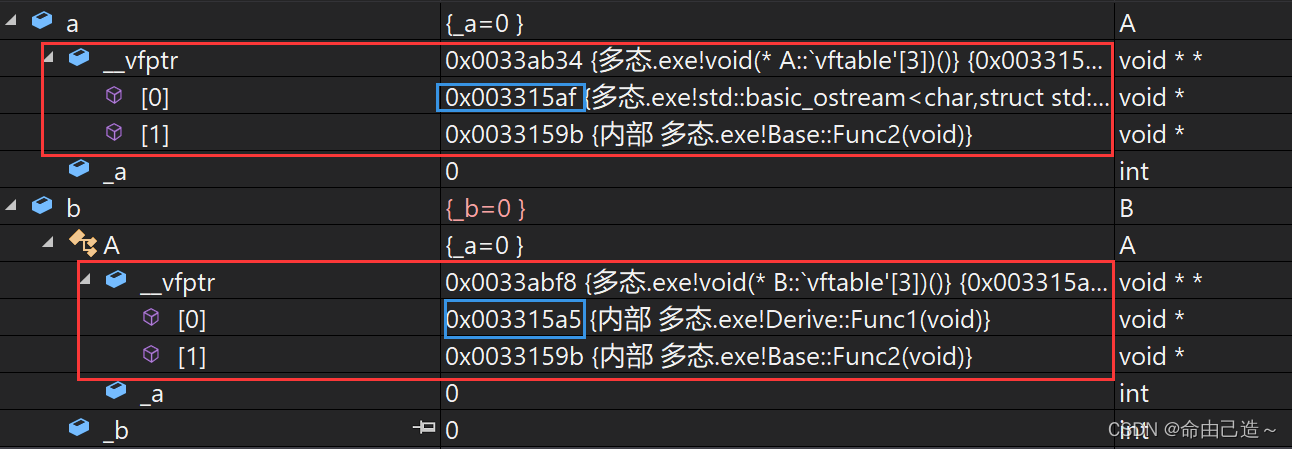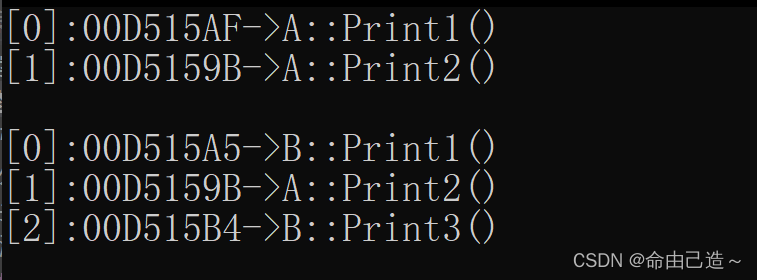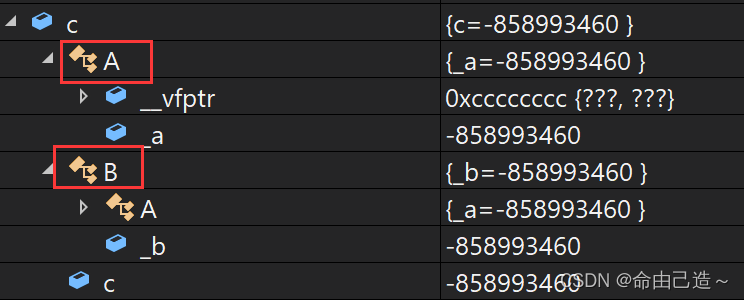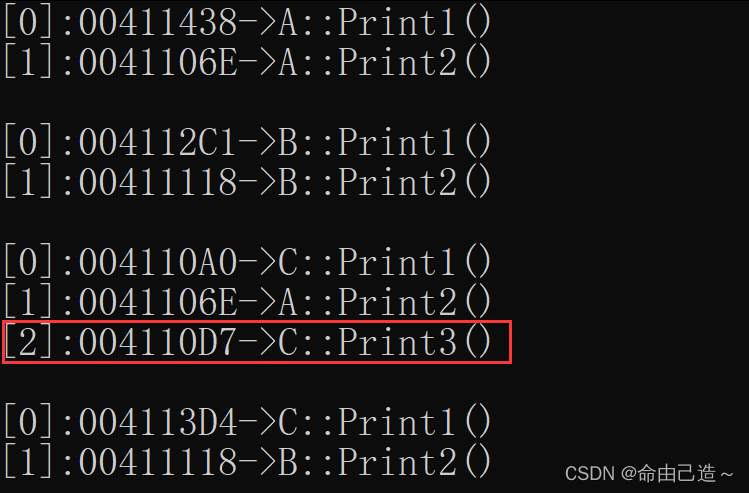【C++】多态
多态
- 一、多态的概念及定义
- 1.1 虚函数
- 1.2 虚函数重写的特殊情况
- 1.3 override 和 final
- 二、抽象类
- 2.1 概念
- 2.2 用处
- 三、多态的原理
- 3.1 虚函数表
- 3.1.1 虚函数与虚表的位置
- 3.2 多态的原理
- 3.3 静态绑定和动态绑定
- 四、单/多继承的虚函数表
- 4.1 单继承的虚函数表
- 4.2 多继承的虚函数表
一、多态的概念及定义
多态:
去完成某个行为,当不同的对象去完成时会产生出不同的状态。
构成多态有两个条件:
1️⃣ 必须是虚函数的重写。
2️⃣ 必须通过父类的指针或者引用调用虚函数
隐藏/重定义的条件:函数名相同
重写/覆盖的条件:函数名、返回值、参数都相同且是虚函数
1.1 虚函数
虚函数:即被virtual修饰的类成员函数称为虚函数
class A
{
public:// 虚函数virtual void Print(){cout << "A" << endl;}
};class B : public A
{
public:// 虚函数的重写/覆盖virtual void Print(){cout << "B" << endl;}
};int main()
{A a;B b;A* pa = &a;A* pb = &b;pa->Print();pb->Print();return 0;
}
结果:
A
B
结论:
普通调用跟的调用的对象的类型有关
多态调用跟指针/引用指向的对象有关
1.2 虚函数重写的特殊情况
1️⃣ 子类的虚函数可以不加virtual
因为子类对象会对父类继承下来的虚函数进行重写。
1️⃣ 协变
返回值可以不同,但必须是父子类关系的指针或引用,父亲就用父类对象,子类就用子类对象。
3️⃣ 析构函数
class A
{
public:~A(){cout << "~A() " << _a << endl;delete []_a;}int* _a = new int[20];
};class B : public A
{
public:~B(){cout << "~B() " << _b << endl;delete[]_b;}int* _b = new int[20];
};int main()
{A* a = new A;A* b = new B;delete a;delete b;return 0;
}
结果:
~A() 015E8820
~A() 015E9738
可以看到发生了内存泄漏delete有两个操作:1、使用指针调用析构函数。2、operator delete()
而因为析构函数没有用virtual所以是普通调用,只与类型有关,全部调用的是A的析构函数。
所以建议析构函数也加上virtual。
1.3 override 和 final
final关键字在父类修饰虚函数,表示该虚函数不能再被重写
class A
{
public:// 虚函数virtual void Print() final{cout << "A" << endl;}
};class B : public A
{
public:// 不能被重写virtual void Print(){cout << "B" << endl;}
};override在子类修饰虚函数,检查子类是否重写,如果没有重写则编译报错
class A
{
public:// 虚函数virtual void Print(){cout << "A" << endl;}
};class B : public A
{
public:// 检查是否被重写virtual void Print() override{cout << "B" << endl;}
};
二、抽象类
2.1 概念
在虚函数的后面写上 =0 ,则这个函数为纯虚函数。包含纯虚函数的类叫做抽象类(也叫接口类),抽象类不能实例化出对象。 派生类继承后也不能实例化出对象,只有重写纯虚函数,派生类才能实例化出对象。纯虚函数规范了派生类必须重写,另外纯虚函数更体现出了接口继承。
class A
{
public:// 纯虚函数virtual void Print() = 0;
};class B : public A
{
public:virtual void Print(){cout << "B" << endl;}
};int main()
{A a; // yesB b; // noreturn 0;
}
2.2 用处
当不能定义出具体的类的时候就可以用抽象类,比如说车的品牌,酒的不同种类。
或者当想要强制重写虚函数的时候也可以使用。
三、多态的原理
3.1 虚函数表
class A
{
public:virtual void Print() {}int _a;
};int main()
{A a;cout << sizeof(a) << endl;return 0;
}
结果:
8
出现这种结果的原因是因为有__vfptr虚表指针。虚表指针放的是虚函数的地址。
class A
{
public:virtual void Print1() {}virtual void Print2() {}void Print3() {}int _a;
};int main()
{A a;cout << sizeof(a) << endl;return 0;
}
结果依然不变,是8。
Print1和Print2会放进虚函数表中:

class A
{
public:virtual void Print1() {cout << "A::Print1()" << endl;}virtual void Print2(){cout << "A::Print2()" << endl;}void Print3(){cout << "A::Print3()" << endl;}int _a = 0;
};class B : public A
{
public:virtual void Print1(){cout << "B::Print1()" << endl;}int _b = 0;
};int main()
{A a;B b;return 0;
}

可以看出子类先拷贝了父类的虚表,完成重写的虚函数,虚表对应的位置覆盖成重写的虚函数。
3.1.1 虚函数与虚表的位置
注意
虚表存的是虚函数指针,不是虚函数,虚函数和普通函数一样的,都是存在代码段的,只是他的指针又存到了虚表中。另外对象中存的不是虚表,存的是虚表指针。而虚表存的位置也是代码段。
3.2 多态的原理
为什么能做到指向父类对象的指针调用的是父类函数,指向子类就调用子类函数。
原因是运行时会找虚函数表,虚函数表就是一个函数指针,来找到对应的虚函数,这种操作叫做动态绑定。
3.3 静态绑定和动态绑定
静态绑定又称为前期绑定(早绑定),在程序编译期间确定了程序的行为,也称为静态多态,
比如:函数重载
动态绑定又称后期绑定(晚绑定),是在程序运行期间,根据具体拿到的类型确定程序的具体
行为,调用具体的函数,也称为动态多态。
四、单/多继承的虚函数表
4.1 单继承的虚函数表
class A
{
public:virtual void Print1() {cout << "A::Print1()" << endl;}virtual void Print2(){cout << "A::Print2()" << endl;}int _a = 0;
};class B : public A
{
public:virtual void Print1(){cout << "B::Print1()" << endl;}virtual void Print3(){cout << "B::Print3()" << endl;}void Print4(){cout << "B::Print4()" << endl;}int _b = 0;
};typedef void(*VfPtr)();void VfPrint(VfPtr vft[])// 打印虚表
{for (int i = 0; vft[i]; i++){printf("[%d]:%p->", i, vft[i]);vft[i]();}cout << endl;
}int main()
{A a;B b;VfPrint((VfPtr*)(*(int*)&a));VfPrint((VfPtr*)(*(int*)&b));return 0;
}结果:

可以看出子类如果有自己的虚函数会放到虚表的最后。
4.2 多继承的虚函数表
class A
{
public:virtual void Print1() {cout << "A::Print1()" << endl;}virtual void Print2(){cout << "A::Print2()" << endl;}int _a = 0;
};class B : public A
{
public:virtual void Print1(){cout << "B::Print1()" << endl;}virtual void Print2(){cout << "B::Print2()" << endl;}int _b = 0;
};class C : public A, public B
{
public:virtual void Print1(){cout << "C::Print1()" << endl;}virtual void Print3(){cout << "C::Print3()" << endl;}int c = 0;
};typedef void(*VfPtr)();void VfPrint(VfPtr vft[])// 打印虚表
{for (int i = 0; vft[i]; i++){printf("[%d]:%p->", i, vft[i]);vft[i]();}cout << endl;
}int main()
{A a;B b;C c;VfPrint((VfPtr*)(*(int*)&a));VfPrint((VfPtr*)(*(int*)&b));// 第一张虚表VfPrint((VfPtr*)(*(int*)&c));// 第二张虚表VfPrint((VfPtr*)(*(int*)((char*)&c + sizeof(A))));return 0;
}对象c有两张虚表(从a和b中继承下来的)。注意多继承不一定有多张虚表,因为有可能有的类没有虚函数。


可以看出多继承中子类虚函数会加到第一张虚表中。
